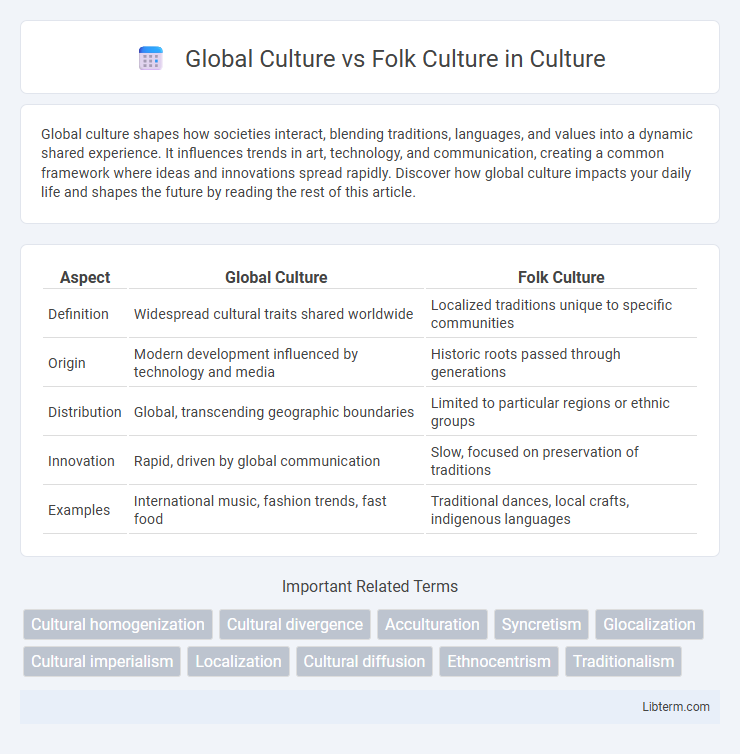Global culture shapes how societies interact, blending traditions, languages, and values into a dynamic shared experience. It influences trends in art, technology, and communication, creating a common framework where ideas and innovations spread rapidly. Discover how global culture impacts your daily life and shapes the future by reading the rest of this article.
Table of Comparison
| Aspect | Global Culture | Folk Culture |
|---|---|---|
| Definition | Widespread cultural traits shared worldwide | Localized traditions unique to specific communities |
| Origin | Modern development influenced by technology and media | Historic roots passed through generations |
| Distribution | Global, transcending geographic boundaries | Limited to particular regions or ethnic groups |
| Innovation | Rapid, driven by global communication | Slow, focused on preservation of traditions |
| Examples | International music, fashion trends, fast food | Traditional dances, local crafts, indigenous languages |
Defining Global Culture and Folk Culture
Global culture refers to shared practices, values, and symbols that transcend national boundaries, shaped by globalization and digital communication, resulting in widespread cultural homogenization. Folk culture consists of localized traditions, customs, and expressions unique to specific communities, often transmitted orally and rooted in historical, indigenous, or rural settings. The distinction highlights global culture's emphasis on mass media and interconnectedness, contrasting with folk culture's preservation of regional identity and heritage.
Origins and Evolution of Global and Folk Cultures
Global culture originates from the widespread diffusion of ideas, technologies, and customs facilitated by globalization, mass media, and international trade, resulting in shared practices across diverse populations. Folk culture emerges from localized, ethnically distinct communities with origins deeply rooted in tradition, environment, and historical continuity maintained through oral transmission and collective memory. The evolution of global culture emphasizes homogenization and cultural convergence, while folk culture evolves through adaptation and preservation of unique cultural identities within isolated or rural settings.
Key Characteristics: Global vs Folk Culture
Global culture is characterized by widespread diffusion, uniformity, and the influence of mass media and technology, leading to shared consumption patterns and lifestyles across diverse populations. Folk culture, in contrast, is marked by localized, tradition-bound practices that preserve distinct customs, languages, and rituals within small, homogeneous communities. While global culture promotes cultural homogenization and connectivity, folk culture emphasizes cultural diversity and the continuity of heritage through oral traditions and artisanal crafts.
Influences of Technology and Media
Technology and media exponentially accelerate the spread of global culture by enabling instant communication, digital content sharing, and virtual interaction across diverse populations. Folk culture, deeply rooted in local traditions and practices, experiences selective adaptation or resistance to these influences, preserving unique customs despite pervasive digital homogenization. Media platforms often commodify folk culture elements, blending them into mainstream global narratives while risking the dilution of authentic cultural identities.
Language and Communication Styles
Global culture often promotes widespread use of dominant languages such as English, emphasizing standardized communication styles driven by technology and media convergence. Folk culture preserves indigenous languages and dialects, maintaining unique communication styles rooted in local traditions, oral storytelling, and contextual nonverbal cues. The contrast between global and folk cultures highlights language shift phenomena and varying sociolinguistic norms essential for cultural identity and intergenerational knowledge transmission.
Symbols, Traditions, and Practices
Global culture promotes universal symbols such as logos and fashion trends that transcend national boundaries, while folk culture preserves unique emblems tied to specific communities, like traditional dress or local motifs. Traditions in global culture rapidly evolve through mass media and technology, contrasting with folk culture's slow, generational transmission of rituals rooted in ancestral heritage. Practices in global culture emphasize shared global values and lifestyles, whereas folk culture maintains localized activities and ceremonies that reinforce community identity and continuity.
Impact on Identity and Social Cohesion
Global culture influences identity by promoting shared values and consumer habits, often leading to cultural homogenization that can weaken traditional customs and social cohesion within local communities. Folk culture reinforces unique identities through localized practices, dialects, and rituals, strengthening social bonds and preserving heritage in the face of globalization. The tension between global culture and folk culture shapes community resilience, as the balance between adopting global trends and maintaining traditional norms impacts social unity and collective identity.
Preservation of Folk Culture in a Globalized World
Preservation of folk culture in a globalized world requires targeted efforts to maintain traditional customs, languages, and artisanal practices threatened by global cultural homogenization. Strategies such as community-based cultural heritage programs, digital archiving of oral histories, and promotion of indigenous knowledge systems play a crucial role in sustaining cultural diversity. International organizations like UNESCO advocate for intangible cultural heritage safeguards to empower local communities against the loss of folk culture amid global influences.
Tensions and Conflicts Between Global and Folk Cultures
Tensions between global culture and folk culture arise as global cultural practices often dominate local traditions, leading to the erosion of unique folk identities and customs. The influx of global media, consumer products, and languages can marginalize indigenous knowledge and rituals, creating conflicts over cultural preservation versus modernization. These cultural clashes provoke debates on cultural homogenization, with many communities striving to protect their heritage against globalizing forces that promote uniformity.
Future Trends and Cultural Integration
Global culture increasingly blends diverse traditions through digital connectivity, fostering hybrid identities and shared values across continents. Future trends indicate accelerated cultural integration driven by technology, migration, and global media, challenging the preservation of distinct folk cultures while creating opportunities for cultural exchange and innovation. Efforts to document and revitalize folk practices coexist with global influences, promoting a dynamic balance between cultural heritage and modern interconnectedness.
Global Culture Infographic

 libterm.com
libterm.com